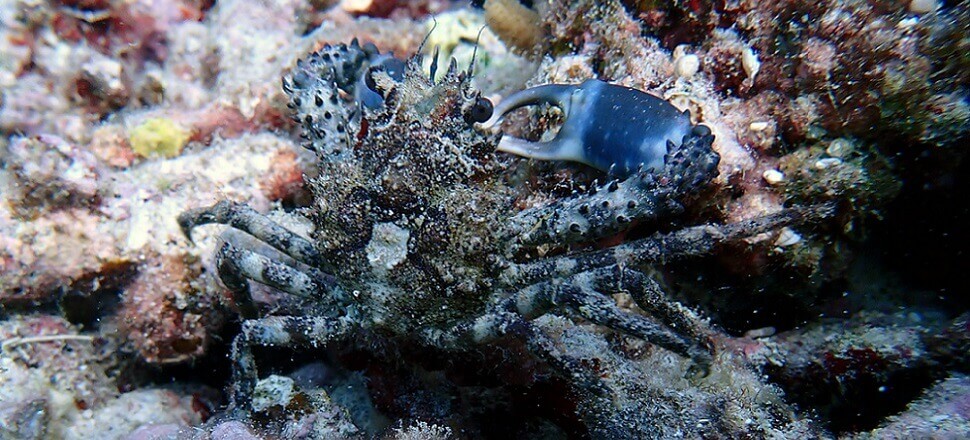From the world
Small crab to the rescue of the Great Barrier Reef
The Great Barrier Reef is a natural wonder of the world, but it has been greatly diminished in recent decades. The threat is not only climate change. How can a small crab contribute to its protection? The crown-of-thorns starfish(Acanthaster planci) is a predator that feeds on corals. According to Australian government estimates, between 1985 and 2012, the organisms were responsible for approx. 40 percent. decline in coral cover. Currently, due to pollution and warming waters, there is a proliferation of crown of thorns populations. According to a study conducted at the University of Queensland, the red decorator crab(Schizophrys aspera) has a voracious appetite for young starfish. “This is one of the largest crown of thorns predators we’ve seen,” said researcher and PhD student Amelia Desbiens. – “This crab may be a natural form of defense against future outbreaks of toxic starfish.”

Red decorator crab(S. aspera) discovery that offers hope for saving the Great Barrier Reef
Amelia Desbiens, a doctoral student at UQ’s School of Biological Sciences, studied more than 100 species of crabs, shrimp, worms, snails and small fish to find an animal that would hunt the predatory starfish. She found that one species excels in the amount of young crown of thorns starfish consumed. The most consistent predator was the red decorator crab(S. aspera) – it consumed starfish at 89 percent. nutrition trials. “We were surprised by its voraciousness. Each red decorator crab devoured more than five starfish a day, while most other species ate as little as one.” – Desbiens said.
The decorator crab is native to the tropical Indo-Pacific and Australia. It gets its name from its ability to coat its exoskeleton with algae, sponges or hydroids to camouflage and deter predators. It reaches a maximum length of 6 cm and can be found at depths of up to 40 m. The little crab’s appetite may explain the mystery of why some reefs avoid outbreaks of crown of thorns starfish while nearby corals are decimated. Predation by the decorator crab(S. aspera) should prompt scientists to further consider its distribution and abundance, especially in the context of focal zones of crown-of-thorns starfish outbreaks. Dr . Kenny Wolfe, co-author of the study on S. aspera, announced that research on the role of the red decorator crab in coral reef conservation will continue.
“This preliminary study sets us on the right path to discovering the role that naturally existing predators may play in controlling the crown-of-thorns starfish epidemic,” – Dr. Wolfe said. – “In addition, this research can pave the way for the preparation of a reef protection program.”
Crown of thorns(A. planci) a threat to the Great Barrier Reef
Coral rubble or dead coral is the preferred home for young crown-of-thorns starfish. These animals have up to 21 arms, more than 600 ovaries and hundreds of thorns ending in venomous spikes. Each individual can eat 10sq. m. of coral per year – and there are millions of them – because they reproduce rapidly due to warming ocean waters. They feed on living corals and leave behind tracts of dead and faded reefs. The spikes make them resistant to most predators. “Few animals successfully eat adult crown of thorns, but young animals are vulnerable because they are small and do not have toxic thorns. This is when predators such as the decorator crab can be most effective,” Desbiens explains. Awareness of this has given scientists a chance to control starfish.

Crown of thorns(A. planci) – the need for predators to control the starfish
In a study conducted on coral reefs in the central region of the Great Barrier Reef, it was shown that large specimens of A. planci (40 cm or more in diameter) ate approx. 161 cm2 of coral surface per day in winter and 357- 478 cm2 in summer. The smaller starfish killed 155 and 234 cm2of coralsurface per day, respectively. A. planci starfish reach an average speed of 35 cm/min, showing that large areas of coral reefs would be destroyed in a relatively short time as a result of the sudden proliferation of crown of thorns if their populations were not controlled by predators.
“This is an ideal time for predators to attack, and for scientists and managers to understand a natural process that can reduce the number of crown of thorns individuals,” – Dr. Wolfe says. – “The crown of thorns reproduces in large numbers and can develop into large populations, which is why it is so important that we quickly find ways to deal with its outbreaks.”
You can read more about coral reefs and what threatens them in the article:“Pacific Ocean coral reefs reveal millions of types of bacteria“.
Photo source: University of Queensland

 Polski
Polski







